Published on: Sep 19 2014
When it comes to fighting Hospital Acquired Infection (HAIs) the general consensus is that cleanliness and good housekeeping plays a major role. Guidelines published by the Department of Health Estates Department are clear and unequivocal in the role that cleaning plays in keeping at bay highly infectious microbiological infections such as Clostridium difficile (C.Diff) and meticillin-resistant staphylococcus aureusis (MRSA).
There have been many concerted and well publicised campaigns in hospitals to encourage staff, patients and visitors to wash their hands for example after handling potentially contaminated surfaces and to report any instances of diarrhoea or intestinal illness as these are the most common sources of the C.Diff infection.
The results have been encouraging, with C.Difficile infection rates in the NHS falling by 59% from their recorded peak of 36, 095 reported cases in 2008/9 to just fewer than 15,000 in 2012/131.
This would indicate that the policy is bearing fruit, but there are concerns that the fruit so far may be ‘low hanging’ i.e.: readily identified sources of infection can be easily isolated and eliminated, but improvements are increasingly harder to attain.
Further research by the Lead infection team at NHS Trafford General (now part of Manchester MRI) found that it became more and more difficult to achieve the ambitious annual reduction targets they had set themselves. Despite rigorous cleaning regimes infection and reinfection rates remained stubbornly higher than anticipated and seemed to worsen during the winter times.
Eventually, suspicion began to fall on the radiators and their LST covers, designed to prevent scalds and burns to patients from the hot metal surfaces. The covers however, seemed to be an ideal breeding ground for micro-bacterial organisms.
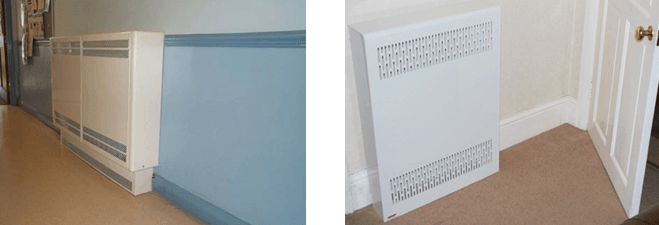
Hospital Guideline HBN 27 states that (radiator) surface temperatures should be no more than 43°C. These guidelines are based on…? It was difficult to ascertain exactly where these guidelines originated as indeed many A&E Dr’s will recognise that patients are often admitted with a core temperature of 40°C+. It is not understood why then that 2~3°C increase could pose such an increased threat to patients. A little further investigation with the Specialist Burns unit at Wythenshawe Hospital, Manchester, pointed towards a report by 2 individuals A R Moritz MD & F C Henriques PHD from the Harvard Medical School in Boston Mass. 'The Relative Importance of Time and Surface Temperature in the Causation of Cutaneous Burns' – 1st published in December 1946!
It appears that this document has largely been cited as the study on which HBN 27 is based, as in the summary it states; 'At surface temperatures between 44° & 51°C, the total exposure time required to destroy the epidermis is essentially identical to the total duration of the steady thermal state within the epidermis, and under these circumstances, the rate at which burning occurs is almost doubled with each degree rise in temperature.'
The report goes on: 'When the temperature of the skin is maintained at 44°C, the rate of injurious change exceeds that of recovery by so narrow a margin that an exposure of approximately 6 hours is required before irreversible damage is sustained at the basal cell level'.
Open and shut then? Not exactly.
The test sample tissues used in the tests were pig skin and the heat source was running water. There are 2 potential flaws in the test data.
So it would seem that the figure of 43⁰C is arbitrary and based on somewhat dated data and in need of a review.
However, as the currents situation is that the surface temperature cannot be higher than 43°C in order to eliminate the risk of scalds, the majority of ‘LST’ radiators are just High Surface Temperature (HST) radiators in a metal box.
In order to deliver the required heat into an enclosed space, the radiators in most hospital, care home and school environments are run at a high temperature, usually sized at 80⁰C flow and 60⁰C return – 80/60 in engineering design parlance.
However in order to prevent the risk of scalds and burns to occupants, they are often encased in a metal surround. The metal surround has 2 significant draw backs:
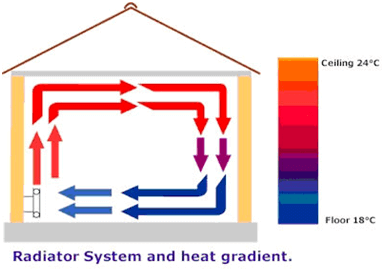
Dealing with points 1 & 2 throws up a couple of interesting conundrums;
Radiators predominately heat a room by drawing up cold air and passing it through the heated surfaces and grilles and fins on the back, throwing a plume of heated air upwards in a vortex to the ceiling, which via a phenomenon known as the coanda effect. The coanda effect (named after a Romanian Engineer) is the effect we see of smoke and other gases tending to cling to a hard surface –either climbing the walls or running across the ceiling. This coanda effect causes the warm air to rise up the wall, and then cling to ceiling after which, as it cools, it falls to ground. This is the process by which radiators heat the far side of the room and as can be imagined is not particularly effective as the warmed air reaches the ceiling heating the upper echelons of the space before being forced down as the room stratifies into layers.
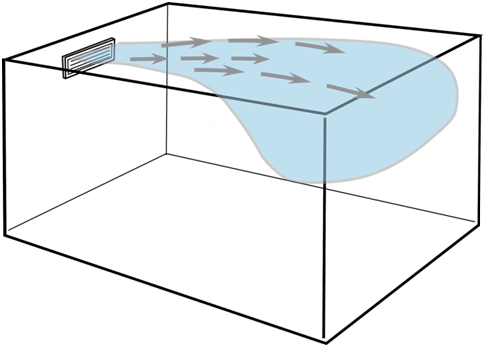
The relatively smaller surface area (say, compared to underfloor heating) of a typical radiator means that the radiant proportion of the heat emitted is around 20~30% of the total, the remaining 60~70% being convected heat.
It is easy to see that interfering with the airflow on a typical radiator can upset its stated performance by a considerable amount, and it’s one of the reasons that additions such as shelves over a radiator and indeed decorative radiator covers have such a detrimental effect on performance and are shunned by the radiator manufacturers themselves.
The situation is further exacerbated in challenging applications such as Dementia Care and Mental Health as anti-ligature requirements can make the grilles and perforations designed to allow warm air out extremely small. These small apertures have the counter intuitive effect of preventing heat escaping leading to a build-up of heat inside the enclosure. Remarkably, during an audit of several anti-ligature radiators in the middle of winter revealed that more than ½ had a resultant surface temperature greater than the HBN 27 guidelines of 43°C – sometimes as high as 55°C. The flow temperature of 80°C required to overcome the poor air flow through the anti-ligature grills was effectively heating the outer surface via radiant heat to a point where they could no longer be considered ‘LST’ covers.
With the primary purpose of the LST covers apparently obviated, it is worth considering the additional hazards they pose in their own right to residents in need of care and treatment.
As previously highlighted these additional hazards can be summarised thus;
According to the last RoSPA HaSS & LaSS reports available from 2000~2002, there were nearly 29,000 radiator related accidents of which nearly 87% were impact, falls, trips or collisions.
Typical injuries were head and shoulders from a full length fall, and leg and shin from either walking or running into the fixed obstruction they create.

Of the remaining 8% were burns & scalds, with the majority (6%) to the hands and arms. Drilling further into the data reveals that 9/10 of these burns to the hands and arms were in the under 2’s and over 65’s. These can be reasonably assessed as ‘grab injuries’ caused by persons unsteady on their feet taking hold of a hot radiator to maintain their balance. Whilst any burn or scald is unwelcome, the primary cause of radiator injury – impact trips and falls is not eliminated by a protective cover or guard. In fact, in many circumstances it could be argued they create a bigger hazard as their proportions have increased commensurate with the cover.
All of us carry the C.Difficile bug in our gut, and from time to time, especially when weakened from other infections or injury, the C.Diff infection can take hold of a patient and lead to a serious deterioration in their condition, or even death. The very old and very young are particularly vulnerable.
The NHS has spent millions of £’s on research into controlling the spread of the infection, which is often excreted by patients in their faecal matter or vomit, and then spread when it becomes airborne. The simple solution is to maintain a high level of cleanliness dealing with accidents and excreta promptly and to wash hands and surfaces with a mild bleaching solution that kills the spores on contact.
It is essential that the cleaning solution can get to the source of any potential infection and so surfaces that are accessible and easily cleaned are a major benefit for the healthcare cleaning professionals.
Unfortunately, LST radiators & covers provide the ideal breeding ground and distribution system for the C.Difficile and to a lesser extent the MRSA infection.
This is because the natural convection currents they create draw cold air from floor level – often carrying the spores that have been deposited there – into the grills and fins of the radiator, trapping infection laden dust dirt and detritus in a warm and dark environment, out of the easy reach of cleaning solutions.
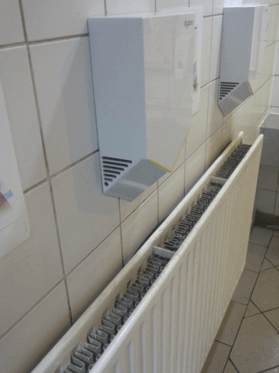
When the radiator is in heating mode, it expels plumes of hot air containing the dust inside (leading to the familiar discolouration of the walls) and spores of the C.Difficile and MRSA infection that have effectively been incubated inside. Given that these convection currents are necessary if the room is to be effectively heated, it should come as no surprise that these LST radiators are now considered a major source of the spread of HAI (Healthcare Acquired Infections) by the NHS.
The only solution to eliminating the dirt and infections that become trapped inside the radiator and covers is a deep clean – using a deep clean team. A deep clean requires the LST covers to be removed and the insides thoroughly cleaned using a mild bleach or similar solution. This appears to be a simple solution but the practicalities and logistics of carrying this out is anything but.
Firstly, the LST covers have to be securely fixed to prevent patient tampering or removal, which will require the deep clean teams to have keys or tools to release them. The hospital may have several different designs and styles from different manufactures, meaning a range of access keys or tools are required and their issue and control carefully monitored.
Once the covers are released, they are often removed all together or in some designs hinge down. As some covers can weigh up to 20Kg, this is not something that an elderly cleaning assistant (male or female) can safely handle, and so 2 persons with appropriate safe weight handling training are required.
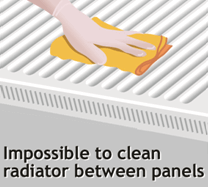
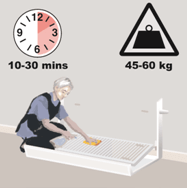
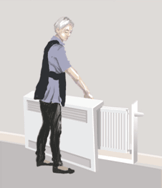
Once removed, the covers themselves become a trip hazard and so parts of the wards or corridors have to be cordoned off to ensure patients and staffs do not take a tumble.
Some LST radiators are difficult to clean the back surface of, and so they are provided with a pivoting mechanism which allows the deep clean team to disinfect the surface closest to the wall. But as the radiator is full of water and made of steel, these can weigh up to 60kg. This would be at least a 2 man lift, and even if not the repetitive strain of raising and lowering radiators and covers for cleaning must be a concern to Estates Management.
Finally, once in position for cleaning, as most LST radiators are ‘double skin’ it is practically impossible to clean between the panels 100%, even with specialist brushes and tools. It is estimated that to carry out all of the above, then at least ½ an hour per LST radiator would be the minimum.
Given that an average hospital has at least 800 radiators (source: Association of Healthcare Cleaning professionals) and that the recommended cleaning cycle is once per week, that would be 400 man/hours a week in radiator cleaning alone.
If the average cost of employing a deep clean team to clean the radiators is £15/hr, then the costs associated with cleaning the LST radiators is(should) be £6,000 a week. Or £300,000 a year...
The practical effect of all this is that the cleaning of the LST radiators is not undertaken anywhere near as often as recommended, to the detriment of the efforts to eradicate HAIs from the Healthcare Environment.
For the Healthcare sector to fight infection, they need a new weapon in their armoury. There are alternatives already available, with mixed results.
Not only do they cause severe discomfort for occupants, being as they heat from the head down, theay can cause distress and behavioural problems for those persons with learning difficulties or dementia. The assymetric temperature differential (i.e. the difference between the surface temperature required to project the heat down and the target room temperature can be so high as to create vortices and aggravate respiratory conditions as the rising air brings dust particles with it.
In addition, whilst cleaning them may require an occasional wipe over to remove accumulated dust, working at height and potentially over infirm patients or sensitive equipment presents a whole new series of challenges.
Anchoring the overhead radiant panels to the ceiling is a particularly rigorous & fraught process, as the consequences of a fixing failing or a pipe coming loose and spilling hot water into the room below can be extremely serious.
(UFH) has been widely adopted in new build Healthcare facilities, (as retro-fitting is practically impossible in a busy hospital), and is often touted as a cleaner and healthier form of heating. This is undoubtedly true as there are no nooks and crannies for the C.Diff or MRSA spores to hide and breed. A simple mop down with typical cleaning solutions will kill any bacteria deposited on the floors, and UFH’s considerably reduced convection currents (typically 30% of the heat emitted is convected) means that the risk of cross contamination to otherwise healthy patients is greatly reduced. Issues tend to arise if there is a failure in the floor heating, or else a change in the buildings layout and activities is required as the heating zones and controls are literally ‘set in stone’.
Other concerns have been expressed by the Royal College of Nurses, as there is growing anecdotal evidence that staff constantly walking and standing on heated floors suffer from circulatory and lower leg & feet problems.
Where UFH also has difficulties, is in responding to the fickle British weather, especially in small enclosed spaces such as bedrooms. Over heating is a common complaint as the heat losses are relatively low in a small room, and the concrete slab can continue to emit heat for several hours after the heating has turned off. This can lead to distress and behavioural issues in persons with learning disabilities or dementia, as well as frustration and complaints from general in-patients.
Coupled with the 6~8 weeks curing time of the screed and the need for careful raising and lowering of the floor temperature with temporary heating to avoid cracking the special screed, there are a number of hidden costs that M&E contractors, Q.S’s and clients are beginning to recognise.
Given that radiant heat is a desirable and comfortable form of heating - provided it is from the feet up and not the head down - and that even heat distribution is a great way to ensure patients are not too hot and not too cold, it would be even better if it could be configured to be responsive to variable weather and occupancy patterns. Ensuring that the radiant heating system could be simply rearranged and repaired without tearing up the floors and yet retain a smooth easily cleaned surface with no nooks and crannies to harbour spores and infections would be highly desirable.
A simple retro-fit onto an existing system (room by room if necessary) and an inherent safe operating temperature and no trip, fall or ligature hazards would surely make such a heating system the holy grail as far as Infection Control, Estates Managers, and Financial Controllers of Healthcare Facilities were concerned.
And yet unlike the Holy Grail, such a system does exist and is being installed in Healthcare, Mental Health and Assisted Living projects all over the UK.
The EasyClean LST has been developed in cooperation with the NHS (specifically the Infection Control Team at Trafford General) and has been designed to provide the inherently simple and responsive nature of an LST radiator, but with the health and safety, hygiene and comfort of a UFH system.
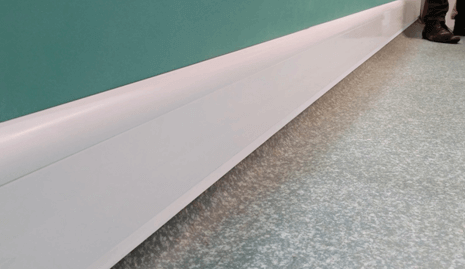
Combing a radiant heating panel into a skirting to floor trim, provides a neat and convenient solution to the heating dilemma faced by Estates Managers and Infection Control personnel.
By providing a water resistant seal to the wall, and an integrated seal to the coved flooring, the heating system can be simply mopped free of infection by the regular cleaning staff, at any time of night or day, with no significant re-training, special tools or deep clean procedures.
By operating at a low surface temperature and being naturally anti-ligature by design, it is perfectly safe for use in critical areas such as mental health, and being completely free of edges or exposed pipework, much less of a trip or fall hazard than conventional LST radiators.
Being an ‘above ground’ wet system, retro fitting onto existing radiator circuits is straightforward, and with the resulting radiant heat being evenly distributed around the room the area is much more comfortable and controllable for the occupants.
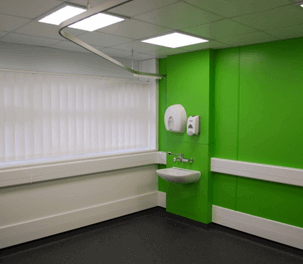
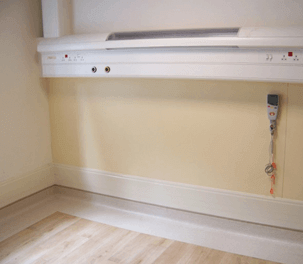
Operating at low temperatures not only makes the system safe for use with the elderly and children but has the added bonus of being more energy efficient than radiator systems that need to be run at 80⁰C in order to get sufficient heat output because (paradoxically) they have to be behind restrictive safety covers because they’re too hot to touch!
As renewables such as Heat Pumps and solar replace more and more fossil fuels the fact that the EasyClean LST system (available from ThermaSkirt) is suitably sized and designed to run at lower operating temperatures means that it effectively ‘future-proof’ should the establishment swap out it’s conventional boiler plant at some point in the future.
However, in the here and now, the immediate benefit to the Healthcare provider is the elimination of virulent and potentially fatal microbiological infections from the heating system and shared air without negatively impacting on cleaning and running costs, or sacrificing patients health, safety, comfort and well- being.